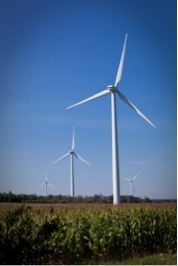Modern wind turbines undergo significant changes in angle of attack and structural loading through a revolution. Recent developments in flow control techniques, coupled with increased interest in green energy technologies, have led to interest in applying flow control techniques to wind turbines, in an effort to reduce structural stress associated with widely varying loading. This reduction in structural stress could lead to reduced operational costs associated with the maintenance cycle. Presented is an investigation into the effect of active flow control on the aerodynamic and structural aspects of an s809 airfoil. Synthetic jets are employed in an open loop control scheme to demonstrate the effect on lift, drag, and vibration of a 3-D air foil at a Reynolds number of 220,000. To build upon previous work, the jets are only actuated during a portion of the cycle, in order to mitigate lift loss at low angles of attack. Also investigated is the use of pulse modulation, in that the jets are pulsed on and off at varying modulation frequencies and duty cycles, in order to investigate if the jets can be actuated for less time, in order to reduce the power consumption of the synthetic jets while achieving the objective of reducing vibration and hysteresis of lift and drag.

Performance Enhancement of a Wind Turbine Blade